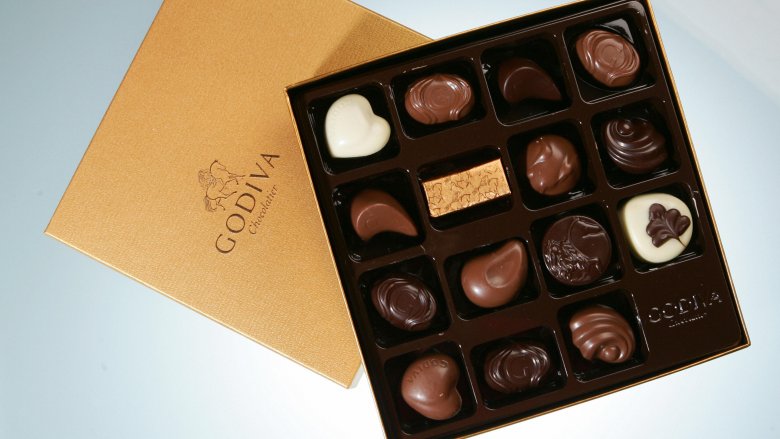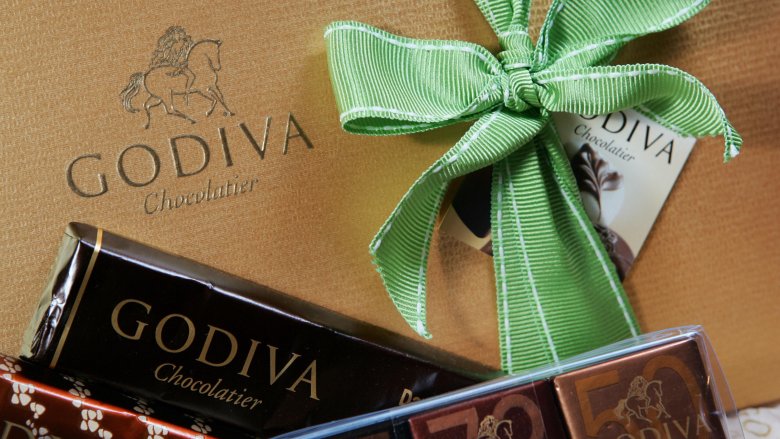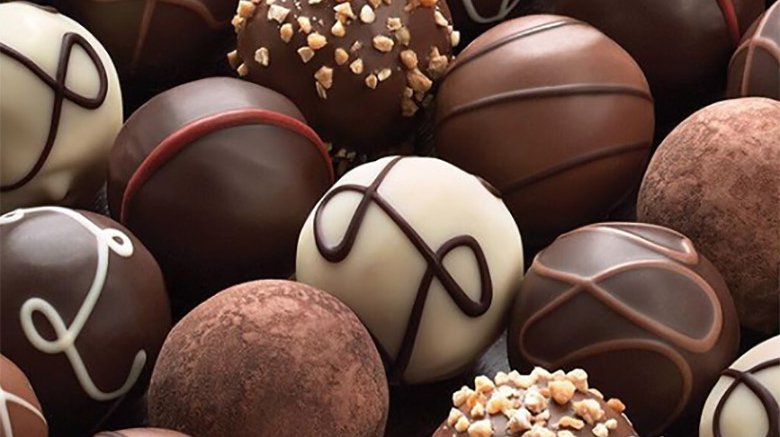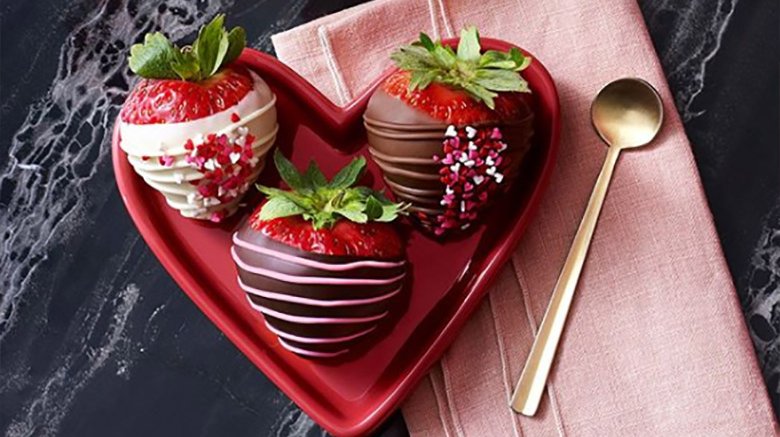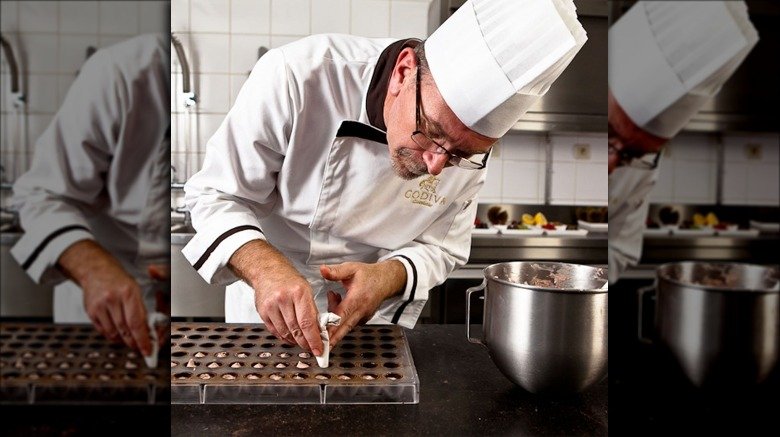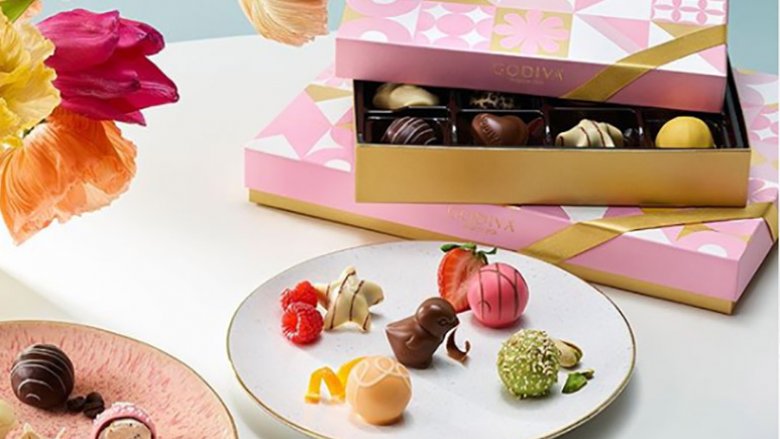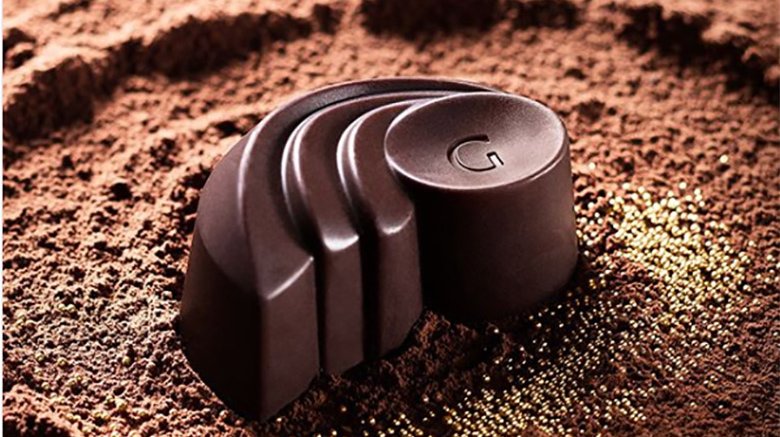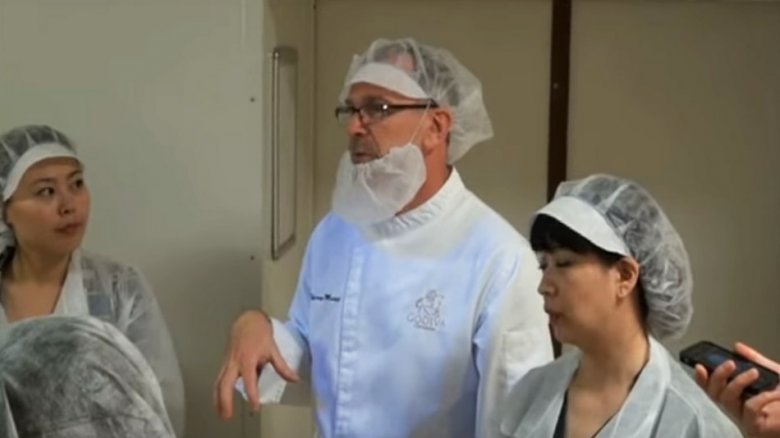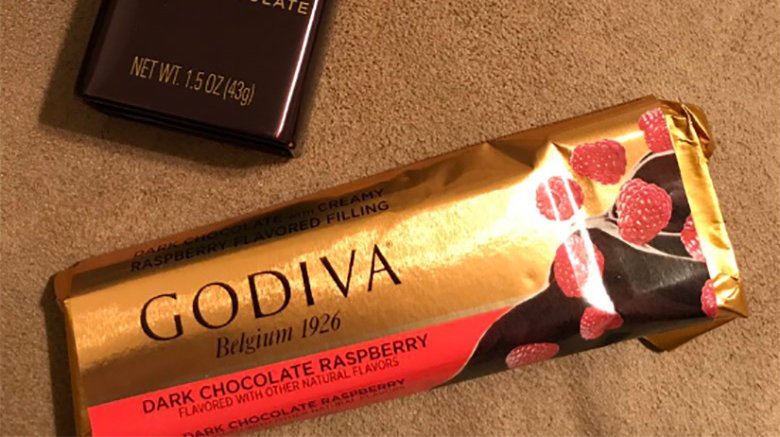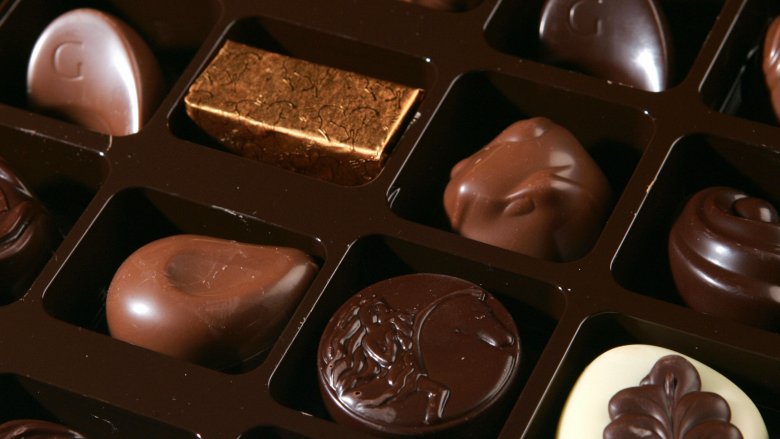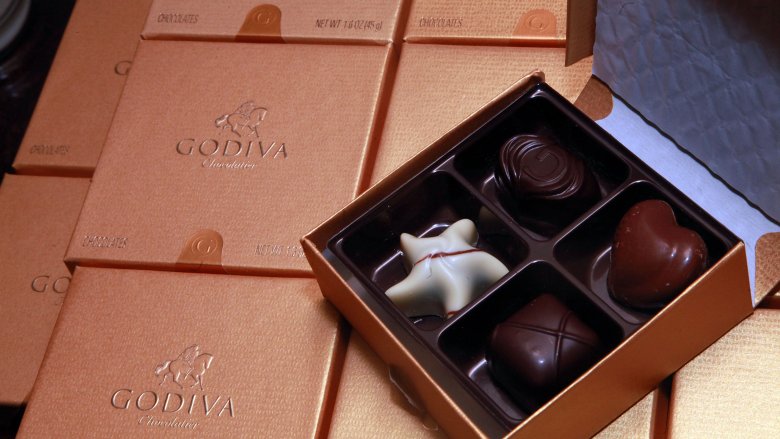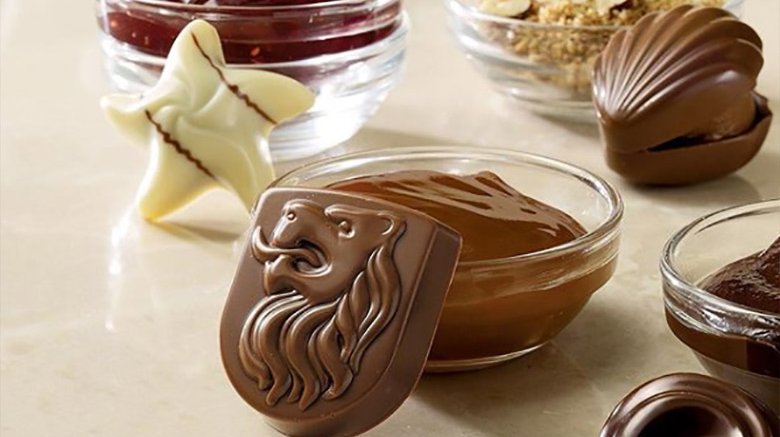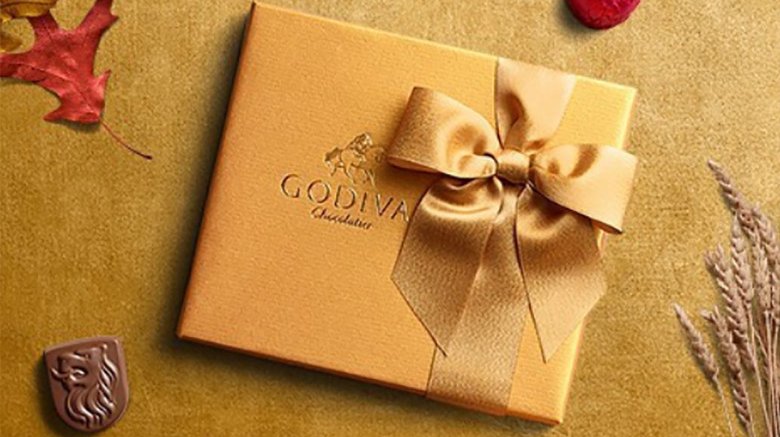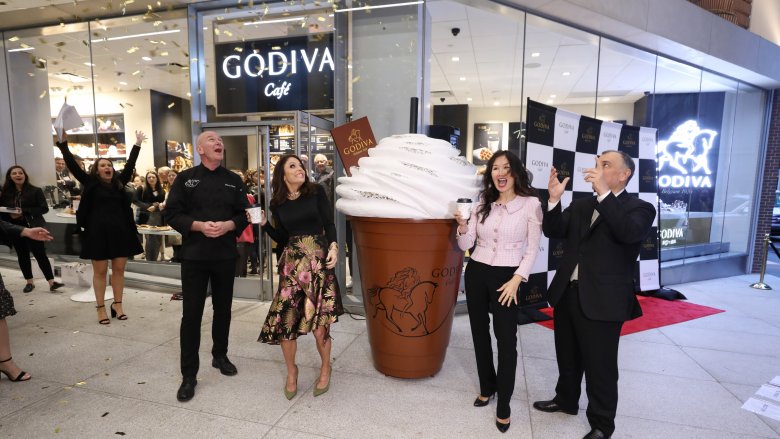The Untold Truth Of Godiva
Mars and Hershey may be two of the most well-known chocolate brands in the United States, but when it comes to chocolate lovers looking for something a little more refined, there's really only one name — Godiva. The Belgium chocolate company has been the king of luxury chocolate for over 90 years and operates some 800 stores in 105 countries.
While Godiva certainly makes candy bars, and even sells its chocolate in chain drug stores like Walgreens, the real star of this candy company are its pralines — or truffles or bonbons, if you prefer. The story of Godiva is one that started in a family kitchen in Brussels, but over time grew to become a worldwide chocolate empire that is still finding new culinary territories to explore today. From its iconic gold box and naked lady logo to its chocolate-making process and ingredient controversies, here's everything you ever wanted to know about the sweet world of Godiva chocolate.
It took its namesake from an 11th-century rebel
Buy any box of Godiva chocolates and you'll see the brand's iconic logo on the packaging — a naked lady riding a horse. So what's a woman in the buff on a horse have to do with chocolate? Well, as you might have guessed, the logo is a tribute to the namesake of the chocolate brand, Lady Godiva.
About 900 years before Godiva chocolate was born, a not-so-swell guy, Leofric, Earl of Mercia, had a reputation for imposing high taxes on the peasants of present-day Coventry, England. Lady Godiva was married to Leofric and repeatedly asked him to lighten up on the greed, but he refused and said he'd lower taxes the day she rode a horse naked through town. So that's exactly what the rebellious Lady Godiva did... according to legend.
Inspired by the boldness and courage of Lady Godiva's story, Draps saw fit to adopt her name and legendary image for his chocolate company's own name and logo.
Pralines were their first creation
These days, Godiva creates everything from solid chocolate bars to icy treats that are sucked through a straw. But as for the chocolate that started the Godiva empire, it's the praline. While Godiva didn't invent the praline, which refers to a filled chocolate bonbon, the company has certainly become the most well-known purveyor of the candy.
It was in 1926 that Pierre Draps Sr. began mixing ground almonds and hazelnuts with caramelized sugar and encasing them in Belgian chocolate to create Godiva's first pralines. The Draps family kitchen served as the creative hub for the chocolates with the entire family working together to make, package, and sell the chocolates around Brussels. After the senior Draps died in 1937, the younger Pierre Draps stepped in to further develop the chocolates and with his brother Joseph, the siblings eventually opened the first Godiva store on Boulevard Léopold II in Brussels in 1945. A year later, Pierre Jr. developed the Truffe Originale (now called the Original Dark 1946 Truffle), a rich chocolate mousse encased in dark chocolate and dipped in cocoa powder, which remains a best seller to this day.
Not surprisingly, Valentine's Day is very busy for them
Everyone knows that Valentine's Day is one of the biggest sales days in the chocolate business, and Godiva moves some serious chocolate every February 14. It's been reported that 53 percent of women expect some sort of Valentine's Day offering from their partner, and chocolate has long been a go-to gift on the holiday.
Godiva's Northwest regional manager, Dawn Oller, told the New York Daily News that on February 13 and 14 employees typically start prepping the brand's chocolate-covered strawberries as early as "2 or 3 in the morning" to keep up with demand. "Each of our stores dips thousands of strawberries just for those two days," Oller said. "During our busiest time on Valentine's Day, our stores across the country are selling and dipping 16,000 strawberries an hour." It's not just customers' significant others that Godiva caters to on Valentine's Day either. Oller estimates that 30 to 50 percent of people also buy a treat for themselves. After all, who among us can resist chocolate, right?
As for those shoppers waiting until the last minute to buy chocolate? 85 percent of the people buying Godiva on February 14 are men. Way to go, dudes.
Godiva's head chocolatier chef started as a chemist
Becoming the head honcho of a worldwide chocolate brand is one of those dream jobs that brings with it a certain amount of mystery. After all, how exactly does one get the job of Godiva's head chocolatier chef? As you might have guessed, there's more to it than just a background in eating a lot of bonbons. (Though the head chef does eat around 20 pieces a day.)
Executive chef chocolatier Thierry Muret actually started out in chemistry before moving into the world of chocolate, and it's that background that has helped make him a master in the field. The chef studied molecular-level crystal formation at the University of Belgium and only took an apprenticeship in the early 1980s with a chocolate chef to help out his sister who had aspirations of starting her own chocolate company. Once Muret realized that there was a heavy dose of science involved in the tempering process, there was no looking back.
As for creating Godiva's flavors, Muret told Vice that the chemistry comes into play when he finding a way to connect flavors that work well together. "It's really two stages: Find the harmony of flavors, and when that's established and we've found something that's pleasing, then we start to look into the science and say, 'This is the target of how we are going to make this.'"
Smell is crucial in the creation process
Before you even pop a well-crafted piece of chocolate in your mouth, your sense of smell is already cuing your brain on what's ahead. It's exactly this importance of smell in relation to taste that is at the root of Godiva's creative process. "Basically what you need to realize is your ability to taste food comes from 80 percent aromatics," executive chef chocolatier Thierry Muret said. "So when you're chewing on food, it releases those aromatics."
Because our tongues can only taste five basic tastes (sweet, sour, bitter, salty, and umami), Muret and other chocolate chefs place a great deal of emphasis on the aromatic side of their chocolate creations. "When you start melting food, chewing the food, you're releasing aromatic compounds," Muret said. "Complexity comes from those aromatic compounds."
This complexity of aromatic compounds that can be found in chocolate is incredibly vast. According to Scientific American, roasted cacao beans yield over 600 flavor compounds that can smell like anything from cooked cabbage to raw beef fat. Of course, nobody wants a cabbage-flavored praline, so if it's going to taste like a white chocolate lemon truffle, it better smell like one first.
Some flavors are trickier than others to get right
Bonbons and other finely-crafted Belgium chocolates like the ones made by Godiva are made to be enjoyed in a single bite so that a person fully gets a "cocktail of all the tastes together." Crafting that perfect cocktail of flavors into one single piece of chocolate isn't always an easy task. It's certainly not one that's perfected in a day, and designing a new collection of Godiva chocolates often takes about 18 months.
Muret and other Godiva chocolatier chefs might work on developing up to 30 new flavors in a year, and some flavors are naturally more difficult than others to get just right. The chef told Vice that Godiva's Midnight Swirl chocolate was particularly tricky to pin down because of the bitterness in the 85 percent chocolate ganache. "Bitterness in nature is something humans do not like — it's associated with poisoning so we're wired not to like it," Muret explained. He had to reexamine the makeup of the ganache and said, in the end, the "composition was very mathematical" because it required the right balance of cocoa butter, cocoa powder, and chocolate liqueur to tame the bitter aspect.
Factory visitors must go through a scrub down process
Willy Wonka may have been foolish enough to have let a bunch of dirty kids and their parents into his factory, but they wouldn't have made it past the lobby doors at Godiva.
Delish writer Candace Braun Davison was lucky enough to visit Godiva's factory in Brussels and noted that cleanliness isn't something Godiva takes lightly. Anyone fortunate enough to be invited in to see where the magic happens must first be thoroughly sterilized and properly outfitted. After assuring the Godiva authorities that you're free of every disease and illness from Hepatitis A to the flu, visitors must remove all jewelry and double wash their hands. It's at this point visitors are dressed from head to toe like a doctor about to head in for surgery.
Godiva visitors are outfitted in white jackets, shoe covers, hair nets, and even beard nets. As Davison pointed out, it's obvious that the Godiva factory isn't "Candy Land" and they're not about to have somebody jeopardizing the reputation of their white chocolate strawberry truffles.
Not all the chocolate is made in Belgium
Godiva may have started in Belgium, but that doesn't mean every piece of chocolate sold by the company is made in Brussels. In fact, there's a good chance that if you're eating a piece of Godiva that was purchased in the United States, it was likely made right here in the USA. Godiva was bought by Campbell's Soup Co. — though they no longer own it — in the 1960s and a Godiva plant in Reading, Pennsylvania has been pumping out the chocolates ever since.
This American-made Godiva hasn't always been easy to swallow with some chocolate consumers, though. In 2019, Steve Hesse and Adam Buxbaum filed a lawsuit against Godiva, arguing that the brand misrepresented the product because "Belgium 1926" on the wrapper falsely implied that it was made in Belgium. Naturally, Godiva disputed the lawsuit's claims and the $5 million in damages Buxbaum and Hesse wanted. The case was eventually dismissed and Godiva clarified any confusion by releasing a statement that explained the "Belgium 1926" logo is a way of "paying homage to the time and place where our story first began." Duh.
The Belgian chocolates are different from the US chocolates
Don't expect the folks at Godiva to show favoritism to one version of their chocolate over the other. "Our couverture, or chocolate coating, is precisely the same as what we use in Brussels because we contract with a manufacturing facility to process it identically and to ship {it} to both plants," David Albright, then-president of Godiva Worldwide told The Washington Post in 1994.
This doesn't mean that the chocolates don't have subtle differences. For example, the American-made Godiva truffles are a little more round than the Belgian ones. Then, of course, there's the issue of ingredients. Many U.S. states have restrictions on alcohol in candy. This means that the U.S.-made Godiva chocolate is, of course, different than its liquor-enhanced European counterpart. There's also a difference in the sugars used in the American versus European Godiva chocolate. For example, in the chocolates made in Reading, Pennsylvania, cane sugar is used, whereas in Belgium beet sugar goes into those chocolate truffles. Godiva officials admit that the two sugars might be different in their raw state but assure customers that in the end, there's no difference. Of course, some palates may disagree.
People can't agree if the American or European chocolates are better
Because the American Godiva chocolates are made with different ingredients, the ultimate question is: Which version of Godiva tastes better? It's not an easy question to answer and is naturally a source of heated debate among chocolate lovers.
"I'm not positive I could tell you the difference blindfolded, but the American and Belgian tastes really are quite different," Giselle Eggermont, first secretary at the Embassy of Belgium in Washington told The Washington Post. Albright said that some people assume that Americans want sweeter chocolate, but argues that assumption doesn't apply to "sophisticated chocolate eaters." However, the mint and caramel Godivas do tend to sell better in the U.S., whereas the Europeans are all about marzipan and hazelnut.
As for which chocolate really does taste better, well, it's very possible that it's all in your mind... and location. Then-general manager of Godiva's European operations, David Johnston, said he believed the taste is largely based on our own perception. "If I go to Bordeaux to drink the wine, it's got to taste better than if it were put in a ship and carted 'round the world."
Perhaps the ultimate way to settle the debate is to eat the American-made chocolate in Belgium and the Belgian-made chocolate in Pennsylvania, and see how it shakes out.
Removing alcohol from the recipe caused some controversy
Make no mistake about it, people take their chocolate very seriously and when a company as world-renowned as Godiva makes a major change, it causes a bit of a stir. In 2007, Godiva was sold to Turkish company Yildiz, and in 2017, Yildiz changed how Godiva's European chocolates were made by removing alcohol from the recipe. Uh oh.
Because Yildiz is based in a country where the majority of the population is Muslim, the company felt pressure to remove alcohol from Godiva's chocolates because consumption of alcohol is prohibited in the Islam religion.
European chocolates such as Toblerone and Cadbury had faced backlash for altering their recipes to be more appealing to Muslim customers, and Godiva faced similar criticism. The Jerusalem Post reported that some on social media accused the chocolate company of breaking tradition and "bowing down to Islamic law."
It's actually pretty common for companies to alter their products to appeal to a wider customer base. Coke, for example, became Kosher in the 1920s after lobbying from the Jewish community and more fast food companies these days are expanding into vegan options.
It's all about the gold box
The gold box has always been closely associated with the Godiva brand. The chocolatier even has a Gold Collection of its "most treasured chocolates" to honor its history and that iconic gold box. Oh, and the proper name for that gold box at Godiva is "ballotin."
Being that gold is a universal symbol of luxury and Godiva prides itself on being a luxury chocolate brand, gold was an obvious pick. It's been the packaging of choice since Godiva's start. "We always hear that consumers say 'wow' when they see that gold box," marketing vice president Michelle Chin told Adweek.
The gold foil box has changed somewhat slightly over the years, too. They were originally wrapped with gold string, but the company now opts to use a gold satin ribbon. According to chocolate expert Clay Gordon, the gold box has played a huge role in molding the company's image. "It's what cemented the connection between Godiva and luxury chocolates in the American mind," he said.
Godiva is rather protective of that "connection," too. In 2005, Godiva took issue with a chocolate company in Tennessee that was also using a gold box to package their candies. Word to the wise, if you're thinking of getting into the chocolate biz, you had better pick a color other than gold for your packaging.
They're expanding their brand into cafes
While Godiva's 90th birthday party in 2016 was all about honoring the company's history, it was also about looking forward. Vice president of marketing Michelle Chin addressed guests by quoting Pierre Draps Jr.: "He said, 'Chocolate is a dream.' And that's an inspirational quote for us... We recognize where we've come from, and we recognize the values this band stands for. But it is a dream. And a dream is always continuous, and so we're always looking at where we go from here."
A big part of "where we go from here" for Godiva is attracting younger consumers, and that means more than just candy in a box. In 2019, Godiva announced a massive plan to launch 2,000 cafes over the course of six years. Look out, Starbucks, Godiva's comin' for ya. The cafes — which have already opened in New York City — include things like a chocolate-stuffed pastries, as well as sandwiches, salads, and chocolate-flavored coffee drinks, of course.
The chain coffee market is incredibly competitive, but Godiva already has a secret weapon. Annie Young-Scrivner became Godiva's CEO in 2017, and who better to lead the charge into the cafe space than a former Starbucks executive? Godiva's executive chef Thierry Muret worked on the menu for a year and Godiva has some lofty goals with its new cafe plans — Young-Scrivner reportedly wants to increase Godiva's revenue five-fold by 2025. They'd better hope their coffee is as good as their chocolate.
